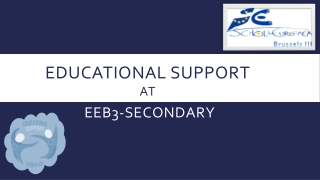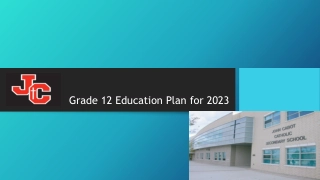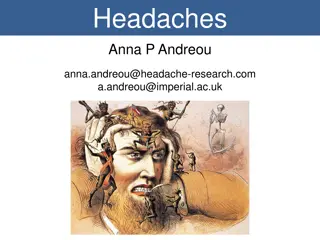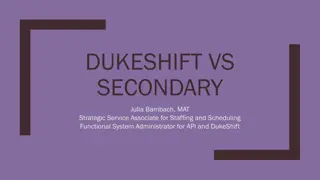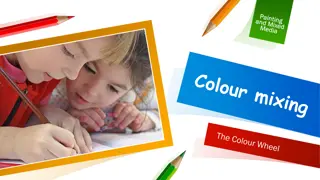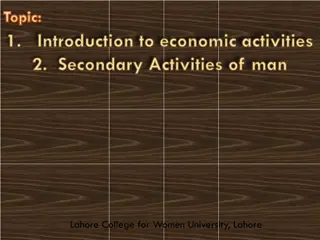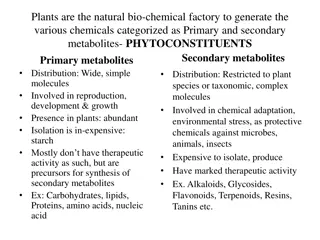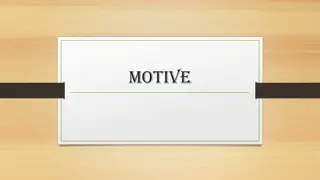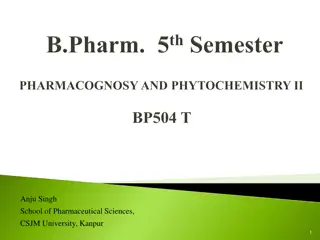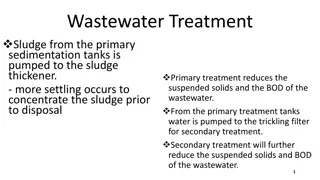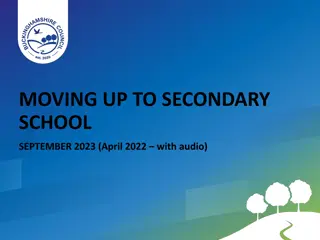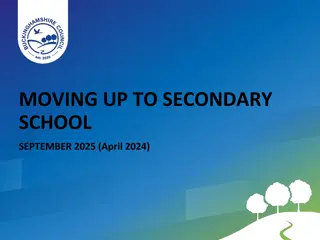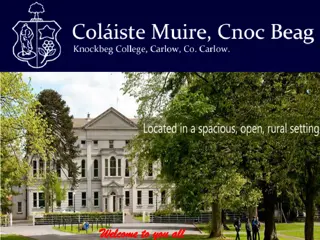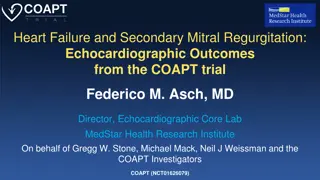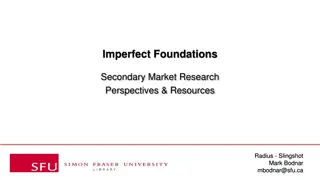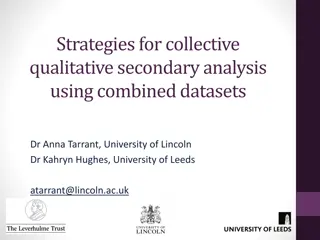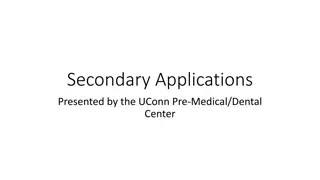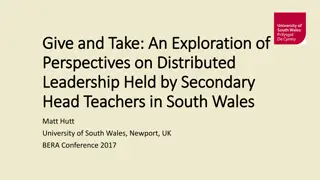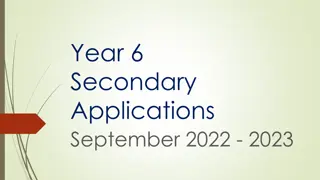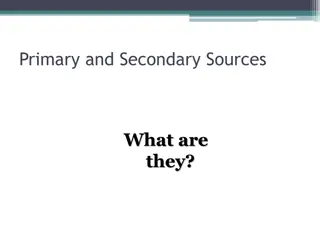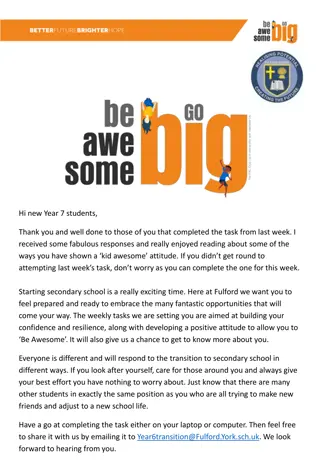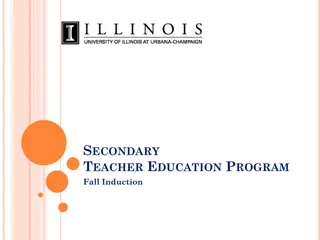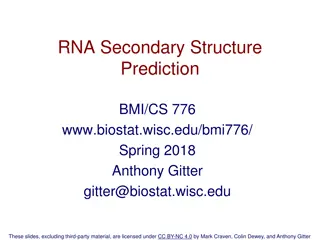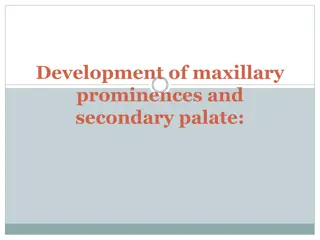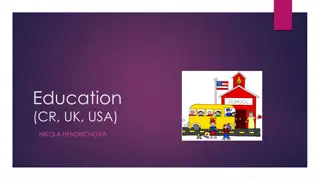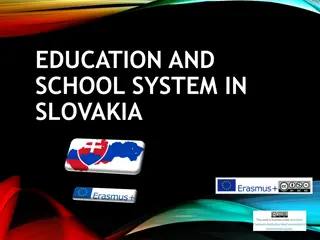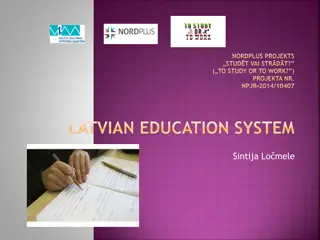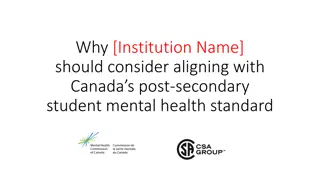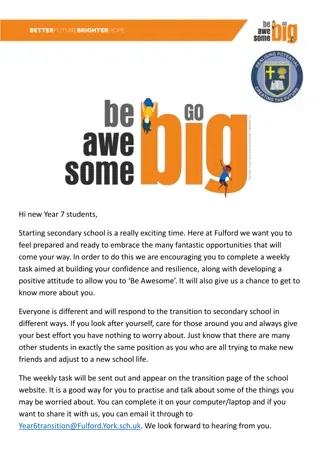Educational Support at EEB3 Secondary
The Educational Support Team at EEB3 for 2023-2024 offers various support services for students, including primary-secondary differences, inclusive education, special arrangements, and different types of support. Learn how primary and secondary support systems differ and the holistic approach to pre
0 views • 14 slides
Grade 12 Education Plan for 2023
A comprehensive look at the Grade 12 education plan for 2023, including graduation requirements, course selection, math pathways, post-secondary destinations, and more. The content covers topics like compulsory credits, optional courses, and a spirit of seeking knowledge. It also includes a land ack
0 views • 25 slides
Understanding Headaches: Classification, Symptoms, and Approach to Treatment
Headaches are a common health issue affecting a significant portion of the global population. This content provides insights into different types of headaches, including primary and secondary classifications. It discusses the importance of accurate diagnosis through history-taking, physical examinat
2 views • 25 slides
DUKESHIFT VS SECONDARY
DukeShift allows managers to post open shifts for eligible and qualified staff, offering extra shifts filled either by float pool staff or preassigned secondary employees. Secondary hiring managers may opt not to use DukeShift due to various reasons, such as hiring PRNs, tracking time on secondary t
0 views • 19 slides
Enhancing Secondary Channel Usage in IEEE 802.11 Standards
This document, IEEE 802.11-23/1935r1, delves into the intricacies of secondary channel usage within the context of IEEE 802.11 standards. Key topics covered include discussions on RU index, BW negotiation in secondary channels, methods to ensure medium synchronization when transitioning back to prim
0 views • 14 slides
Understanding the Basics of Color Theory
A color wheel organizes colors into primary, secondary, and tertiary categories. Primary colors are red, blue, and yellow; secondary colors are green, violet, and orange; and tertiary colors are mixtures of primary and secondary colors. The value of a color refers to how light or dark it is, with ti
3 views • 10 slides
Understanding Secondary Economic Activities in Lahore College for Women University
Economic activities are classified into five types, with secondary activities involving the processing of raw materials into industrial products. This sector, including manufacturing and industry, plays a crucial role worldwide. Examples of secondary activities range from metalworking to textile pro
4 views • 18 slides
Transition from Primary to Secondary School Mathematics Introduction
Transitioning from primary to secondary school in mathematics is crucial for developing essential skills in reasoning, problem-solving, and teamwork. This journey involves exploring new mathematical concepts, vocabulary, and number systems while delving into exciting units like proportions and data
0 views • 16 slides
Understanding Plants: Primary Vs. Secondary Metabolites and Alkaloids
Plants act as natural bio-chemical factories producing primary and secondary metabolites with distinct roles in growth and adaptation. Primary metabolites are essential molecules like carbohydrates and proteins, while secondary metabolites like alkaloids have marked therapeutic activities. Alkaloids
0 views • 7 slides
The Role of Secondary Eye Care in Relation to Primary Eye Care
Secondary eye care services, located in hospital settings, play a crucial role in providing specialized diagnostics, treatment, and rehabilitation to a large population. They serve as the first contact point for specialist services, contributing to successful referral pathways and collaborative part
0 views • 5 slides
Understanding Motives: Primary vs. Secondary Motives and Their Impact
Motives are incentives that drive human behavior, divided into primary (biological) and secondary (psychosocial) types. Primary motives are essential for survival, such as hunger and thirst, while secondary motives, learned through life experiences, influence personality development. Social motives
0 views • 18 slides
Overview of Secondary Metabolites: Alkaloids, Flavonoids, Steroids, and Glycosides
Exploring the diverse world of secondary metabolites, this content delves into the composition, chemistry, biosources, therapeutic uses, and commercial applications of various compounds such as Alkaloids, Flavonoids, Steroids, Glycosides, and more. It discusses the structural characteristics, biolog
0 views • 17 slides
Understanding Secondary Growth in Plants: Boerhaavia (Dicot) vs. Dracaena (Monocot)
Secondary growth, resulting from cambial cell division, thickens stems and roots in plants. This process involves cambium, a tissue layer between xylem and phloem, responsible for secondary growth. Cambium ray initials give rise to vascular rays and secondary xylem/phloem. The seasonal activity of c
0 views • 24 slides
COVID-19 Situation in Secondary Schools and Boarding Facilities
COVID-19 situation in secondary schools as of January 26, 2021, presented by the Ministry of Education. All schools were closed on January 18, 2020, with boarding school learners retained for assessment and testing due to mass infection. Students are isolated following health guidelines. A summary o
1 views • 12 slides
Overview of Wastewater Treatment Processes
Wastewater treatment involves primary and secondary processes to reduce suspended solids and BOD levels. Primary treatment utilizes sedimentation tanks followed by sludge thickening, while secondary treatment involves biological methods such as trickling filters. Various secondary treatment methods
0 views • 15 slides
Overview of Fingerprint Classification and Cataloguing Methods
Explore the basics of fingerprint classification, including Henry Classification and NCIC Classification systems. Learn about the importance of classification in establishing protocols for searching and comparison. Discover the components of Henry Classification, such as primary, secondary, sub-seco
1 views • 21 slides
Overview of Secondary Metabolites: Alkaloids, Glycosides, Flavonoids, and More
Secondary metabolites are chemical compounds produced by plants that have various biological effects. Alkaloids, a type of secondary metabolite, are organic compounds with nitrogen atoms and specific physiological actions. They exhibit diverse physical and chemical properties, making them essential
0 views • 63 slides
Moving Up to Secondary School: Application and Testing Processes Overview
In September 2023, students are transitioning to secondary school in Buckinghamshire. The presentation covers the application and offer processes, the Secondary Transfer Test, timelines, key messages, and how to apply for a school place online. It ensures parents and students are well-informed about
0 views • 38 slides
Guide to Applying for Secondary School Places in Buckinghamshire
This guide provides detailed information on applying for secondary school places in Buckinghamshire. It covers key aspects such as when to apply, the application process, considerations when choosing schools, the Secondary Transfer Test, and how to contact the Admissions Team. The guide emphasizes t
0 views • 41 slides
Supporting Students' Success in Secondary School
Parents play a crucial role in shaping students' experiences in secondary school. By providing support, encouragement, and fostering a positive attitude, students can navigate the challenges of secondary school with confidence. The transition to secondary school can be daunting, but with the right g
0 views • 29 slides
Echocardiographic Outcomes in Heart Failure Patients with Secondary Mitral Regurgitation: COAPT Trial
This study presents the echocardiographic outcomes from the COAPT trial focusing on heart failure patients with secondary mitral regurgitation. The trial evaluated the impact of MitraClip therapy in conjunction with guideline-directed medical therapy compared to medical therapy alone. Results showed
0 views • 27 slides
Exploring Imperfect Foundations in Secondary Market Research Perspectives
Delve into the world of secondary market research perspectives with a focus on imperfect foundations. Discover the importance of asking good questions, evaluating everything, and building a strong research foundation. Learn why secondary research plays a crucial role despite its flaws and how to app
0 views • 21 slides
Strategies for Collective Qualitative Secondary Analysis Using Combined Datasets
Collective qualitative secondary analysis involves reusing data through a collaborative lens, embracing multiple viewpoints to gain deeper insights. The approach emphasizes the constructed nature of research data and allows for diverse interpretations and engagements. This article discusses the proc
0 views • 15 slides
Understanding UConn Pre-Med/Dental Secondary Applications Process
Explore the details of secondary applications presented by the UConn Pre-Medical/Dental Center, covering topics such as what secondary applications entail, submission processes, timelines, common questions, and tips/resources. Learn the importance of secondary applications in differentiating yoursel
0 views • 24 slides
Exploring Distributed Leadership Perspectives Held by Secondary Head Teachers in South Wales
This research delves into the perspectives on distributed leadership (DL) held by secondary head teachers in South Wales. The study aims to understand how head teachers define and implement distributed leadership in their schools, exploring concepts such as trust, accountability, and the role of ext
0 views • 18 slides
Complete Guide to Year 6 Secondary School Applications in Brent - 2022-2023
Explore the Year 6 Secondary Applications process for children born between 1st September 2011 and 31st August 2012 in Brent. Learn about the application timeline, deadlines, offer day, and school start date. Find out how to apply online, choose up to 6 schools, and accept offers effectively. Avoid
0 views • 14 slides
Understanding Primary and Secondary Sources in Research
Primary sources provide firsthand information from the time period being studied, while secondary sources offer interpretations based on primary sources. Examples of primary sources include autobiographies, speeches, historical documents, published firsthand accounts, and sound recordings. Secondary
0 views • 23 slides
Embracing Secondary School: Weekly Tasks for Year 7 Students
As Year 7 students transition to secondary school, weekly tasks aim to build confidence, resilience, and a positive attitude. Tasks include unlocking the mind-set, addressing worries, and challenging self-limiting beliefs through a growth mindset. Encouraging students to develop a positive approach
0 views • 5 slides
Secondary Teacher Education Program Induction and Resources
Get ready to embark on your journey towards becoming a secondary teacher with the Secondary Teacher Education Program's Fall Induction. Connect with key personnel, explore school and community experiences, visit essential websites, and familiarize yourself with crucial vocabulary and expectations in
0 views • 19 slides
Post-Secondary Scholarship Information and Admission Requirements Overview
Explore valuable insights into post-secondary education, scholarship information, admission requirements for top universities like UBC, SFU, UVic, and BCIT. Discover average admissions scores and essential courses for various programs. Gain advice from current post-secondary students on navigating t
0 views • 24 slides
Proposal for Improved Channel Access Efficiency in IEEE 802.11 Networks
The proposal addresses the inefficiencies in utilizing secondary channels in IEEE 802.11 networks, aiming to enhance access to wideband channels (>20 MHz) when the primary channel is busy. It introduces a mechanism for APs and STAs to access available secondary channels while the primary channel is
0 views • 7 slides
Exploring RNA Secondary Structure Prediction in Bioinformatics
RNA secondary structure prediction is a key concept in bioinformatics, encompassing features like stems, loops, and bulges. This presentation delves into the importance of RNA beyond mRNA, highlighting rRNA, tRNA, and regulatory RNA roles. The canonical base pairs A-U and C-G shape the single-strand
0 views • 20 slides
Development of Maxillary Prominences and Secondary Palate in Embryonic Development
New outgrowths from the medial edges of the maxillary prominences form the shelves of the secondary palate. Fusion of these palatal shelves involves complex cellular changes, such as elevation after the withdrawal of the tongue and alterations in epithelium leading to adhesion and fusion. The fate o
0 views • 23 slides
Overview of the Czech Education System: Levels, Structure & Details
The Czech education system comprises pre-school, primary, secondary, and higher secondary levels. Pre-school education includes nursery and kindergarten, primary education focuses on foundational skills and knowledge, secondary education covers a broader range of subjects, and higher secondary offer
0 views • 16 slides
Protein Secondary Structure Prediction: Insights and Methods
Accurate prediction of protein secondary structure is crucial for understanding tertiary structure, predicting protein function, and classification. This prediction involves identifying key elements like alpha helices, beta sheets, turns, and loops. Various methods such as manual assignment by cryst
0 views • 30 slides
Understanding Liability in Negligence for Psychiatric Injury: Primary and Secondary Victims
Psychiatric damage resulting from negligence involves injury to the mind rather than the body, requiring claimants to prove recognized psychiatric injury with medical evidence. Primary victims suffer physical or foreseeable physical and psychiatric injuries, while secondary victims experience psychi
0 views • 23 slides
Overview of Education System in Slovakia
The education system in Slovakia comprises state schools, church-owned schools, and private schools. It includes different school types such as kindergartens, primary schools, secondary schools, and universities. Primary education is free and compulsory, starting at age 6 and divided into two stages
0 views • 11 slides
Overview of the Latvian Education System
Latvian education system comprises primary, secondary, and tertiary levels. It begins with compulsory and free primary education for children aged 5 to 18. The system includes vocational and general secondary schools, gymnasiums, and higher education establishments. School subjects taught range from
0 views • 13 slides
Enhancing Post-Secondary Student Mental Health in Canada: A Case for Alignment
Student mental health is a critical issue in Canada's post-secondary institutions, impacting over 2 million students with high levels of stress, depression, and suicide ideation. Aligning with Canada's post-secondary student mental health standard can improve outcomes, support well-being, and enhanc
0 views • 9 slides
Embracing the Transition: Building Confidence and Resilience for Secondary School
Starting secondary school is an exciting but challenging time. Fulford School aims to prepare students through weekly tasks inspired by the book "You Are Awesome" by Matthew Syed. The tasks focus on developing a positive attitude, resilience, and confidence. Students are encouraged to share their ex
0 views • 4 slides
